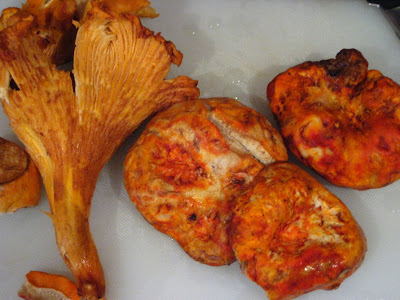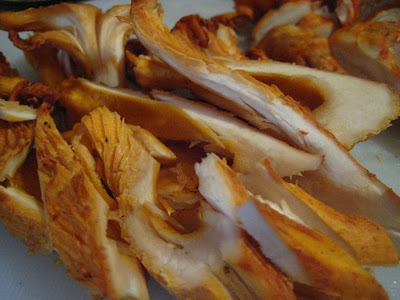The natural world is full of things that resemble other things, sometimes in look, sometimes in smell, and sometimes in taste, too. And after all, human description of food often resorts to simile: "It tastes like chicken." Of course, this gives rise to the joke that God, when defining the tastes of things, ran out of ideas when it came to chicken so just made chicken taste like everything. But I digress.
Lobster would seem to be one of those very delicious, prized, and, above all, unique tastes that is not found anywhere else. Well, whether by reality of the tastebuds or by sheer power of suggestion, a non-lobster lobster seems to exist. The lobster mushroom is so named because it is the speckled orange color of a cooked lobster and also has been described as having a taste that is both earthy and lobster- or shellfish-like. I should clarify that the lobster mushroom is not actually a single species of mushroom in itself, but rather is the result of a parasite fungus colonizing a host mushroom - mushrooms on a mushroom, as it were.
 The parasite responsible for the unique coloring and flavour is Hypomyces lactifluorum and it colonizes various host species, most of which are edible. (The Mushroom Expert) This presents a challenge when determining if a bright orange speckled mushroom you happen across on a hike will make a good mushroom fry-up followed by a pleasant afternoon nap or by agonizing pain and death. In short, DON'T PICK THEM YOURSELF UNLESS YOU KNOW WHAT YOU'RE DOING.
The parasite responsible for the unique coloring and flavour is Hypomyces lactifluorum and it colonizes various host species, most of which are edible. (The Mushroom Expert) This presents a challenge when determining if a bright orange speckled mushroom you happen across on a hike will make a good mushroom fry-up followed by a pleasant afternoon nap or by agonizing pain and death. In short, DON'T PICK THEM YOURSELF UNLESS YOU KNOW WHAT YOU'RE DOING.  Identifying the host (and therefore the edibility) can be very hard since the parasite causes the mushroom to deform a lot as it matures. In France, you could take your mushroom to a pharmacy and they'd tell you if you could eat it, but I think bringing a muddy orange blob to your urban neighborhood pharmacy might cause some consternation. Some universities may have people in the mycology department willing to help determine if a mushroom is edible and these folks also occasionally have mushroom festivals, usually in later autumn or spring.
Identifying the host (and therefore the edibility) can be very hard since the parasite causes the mushroom to deform a lot as it matures. In France, you could take your mushroom to a pharmacy and they'd tell you if you could eat it, but I think bringing a muddy orange blob to your urban neighborhood pharmacy might cause some consternation. Some universities may have people in the mycology department willing to help determine if a mushroom is edible and these folks also occasionally have mushroom festivals, usually in later autumn or spring.  But, lest we get carried away with the fear-mongering, more important is that when you find lobster mushrooms that are edible, you should eat them. They really are quite fabulous and different from other mushrooms I have eaten. My favorite mushroom preparation is to saute mushrooms in a little butter with a pinch of sugar, salt, and pepper until the mushrooms are cooked and the edges are starting to brown. Many mushrooms I have tried cooking like this have become soggy because I have messed up in one of many ways, but the lobster mushrooms did not. They stayed meaty and springy the entire time, so much so that I had some trouble determining when they were done. Finally I poured them and the chantrelles I had cooked with them out onto a bed of spinach, tossed a little salt over the top, and ate. The taste surprised me as I did not expect them to taste at all lobstery, but they did. Perhaps it had something to do with the preparation - buttery with a little salty sweetness? I like to think that somehow the mushrooms are imbued with the aura of lobster. The texture was also surprising, striking me as more bamboo-like rather than mushroom. They were not fibrous, but definitely toothsome - as in "al dente" like pasta. A little meaty even. And really really satisfying.
But, lest we get carried away with the fear-mongering, more important is that when you find lobster mushrooms that are edible, you should eat them. They really are quite fabulous and different from other mushrooms I have eaten. My favorite mushroom preparation is to saute mushrooms in a little butter with a pinch of sugar, salt, and pepper until the mushrooms are cooked and the edges are starting to brown. Many mushrooms I have tried cooking like this have become soggy because I have messed up in one of many ways, but the lobster mushrooms did not. They stayed meaty and springy the entire time, so much so that I had some trouble determining when they were done. Finally I poured them and the chantrelles I had cooked with them out onto a bed of spinach, tossed a little salt over the top, and ate. The taste surprised me as I did not expect them to taste at all lobstery, but they did. Perhaps it had something to do with the preparation - buttery with a little salty sweetness? I like to think that somehow the mushrooms are imbued with the aura of lobster. The texture was also surprising, striking me as more bamboo-like rather than mushroom. They were not fibrous, but definitely toothsome - as in "al dente" like pasta. A little meaty even. And really really satisfying.

No comments:
Post a Comment